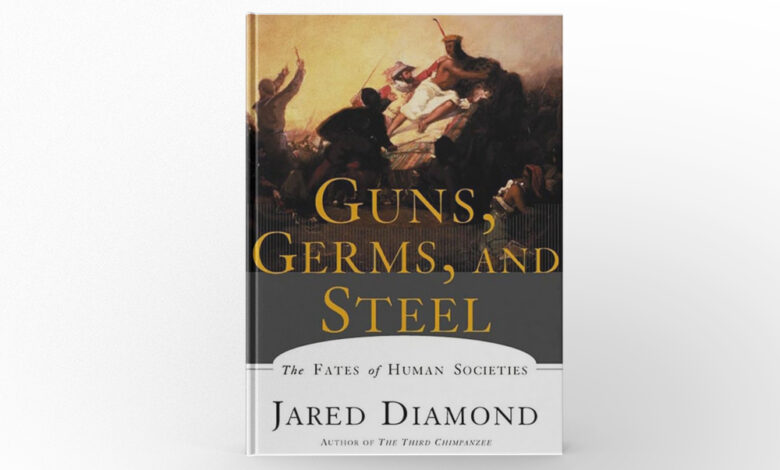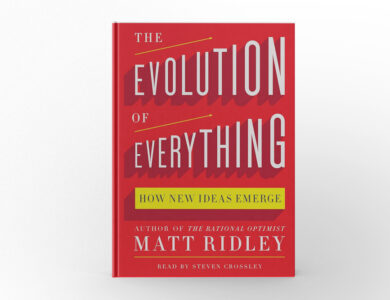Guns, Germs, and Steel by Jared Diamond
Guns, Germs, and Steel: Unraveling the Threads of Human History

“Guns, Germs, and Steel: The Fates of Human Societies” by Jared Diamond offers a sweeping analysis of human history, exploring why some societies have thrived while others have not. This influential book challenges conventional views of historical progress and provides a compelling argument that geography, biology, and environment played pivotal roles in shaping the modern world.
Author’s Background
Jared Diamond is a distinguished professor of geography at UCLA and a renowned author whose work spans various fields, including evolutionary biology and anthropology. His academic background is extensive, with a focus on ecology and the evolution of societies. Diamond’s expertise in these areas allows him to provide a comprehensive and interdisciplinary approach to understanding human history. His previous works, including “The Third Chimpanzee” and “Collapse,” also delve into human evolution and societal development, establishing him as a leading voice in examining the factors that have shaped civilizations.
In Depth Summary
“Guns, Germs, and Steel” is structured around a central question: Why did some societies become more powerful and influential than others? Diamond’s exploration is rooted in the premise that the differences in societal development were not due to inherent differences among people but rather to environmental factors that influenced the course of history.
The book begins by examining the role of geography in shaping societies. Diamond argues that the availability of domesticable plants and animals was crucial to the development of agriculture. Societies that could cultivate crops and rear animals were able to produce surplus food, leading to population growth and the emergence of complex social structures. In contrast, societies with less favorable environments remained hunter-gatherers or practiced subsistence agriculture, which limited their ability to develop advanced technologies and political systems.
One of the key concepts Diamond introduces is the “axis orientation” of continents. He explains that Eurasia, with its east-west axis, had a greater potential for the spread of agriculture and technology compared to Africa and the Americas, which have north-south axes. This geographic advantage allowed for the diffusion of crops, animals, and innovations across similar latitudes, contributing to the rapid development of societies in Eurasia.
Diamond also explores the impact of germs and disease. He posits that the spread of infectious diseases played a significant role in the conquest and colonization of societies. European societies, with their long history of agricultural development, had developed immunities to various diseases. When Europeans encountered indigenous populations in the Americas, Africa, and Oceania, the diseases they brought with them decimated local populations, facilitating European dominance.
The book further delves into the development of writing and technology. Diamond argues that societies with access to writing systems and advanced technologies were better equipped to manage complex administrative tasks, organize military campaigns, and consolidate power. This technological advantage contributed to the rise of empires and the expansion of trade networks.
Diamond also addresses the concept of “cultural superiority” and challenges the notion that some societies were inherently more advanced or intelligent. Instead, he attributes societal success to environmental factors and the ability to adapt to changing circumstances. This perspective emphasizes that societal outcomes were not predetermined but shaped by a combination of geographic, biological, and technological factors.
Themes and Insights
One of the central themes of “Guns, Germs, and Steel” is the influence of geography on societal development. Diamond’s analysis highlights how geographic factors, such as the availability of domesticable plants and animals, shaped the trajectory of human societies. This theme underscores the importance of environmental conditions in shaping historical outcomes and challenges the idea that human ingenuity alone drives progress.
Another significant theme is the role of disease in shaping history. Diamond’s exploration of the impact of germs and diseases on societal interactions reveals how health crises can alter the course of history. This theme emphasizes the interconnectedness of human societies and the unintended consequences of contact between different populations.
The book also addresses the concept of technological and cultural evolution. Diamond’s analysis of the development of writing systems and technological innovations demonstrates how these advancements contributed to the rise of complex societies and the consolidation of power. This theme highlights the importance of technological progress in shaping historical outcomes and challenges the idea that cultural superiority determines societal success.
Personal Reflections
Reading “Guns, Germs, and Steel” offers a profound understanding of the factors that have shaped human history. Diamond’s interdisciplinary approach provides a comprehensive perspective on the forces that have influenced societal development. The book’s emphasis on environmental factors and geographic advantages challenges conventional views of historical progress and offers a fresh perspective on the complexities of human evolution.
Diamond’s ability to synthesize information from various fields, including geography, biology, and history, makes the book both engaging and informative. The detailed analysis of how geography and disease have shaped human societies provides valuable insights into the dynamics of historical change and the factors that have contributed to societal success.
Recommendation
“Guns, Germs, and Steel” is essential reading for anyone interested in understanding the forces that have shaped human societies. The book’s interdisciplinary approach and thorough analysis offer valuable insights into the development of civilizations and the factors that have influenced historical outcomes. It is particularly relevant for readers interested in history, geography, and anthropology, but it is accessible to anyone curious about the underlying forces that have shaped the modern world.
Impact and Legacy
The impact of “Guns, Germs, and Steel” has been significant, both in academic circles and popular discourse. The book has received widespread acclaim for its innovative approach to understanding human history and its challenge to traditional explanations of societal development. Diamond’s emphasis on environmental factors and geographic advantages has influenced subsequent research and discussions in fields such as anthropology, history, and sociology.
The book’s legacy extends beyond academia, contributing to a broader understanding of the forces that have shaped human societies. It has sparked discussions on topics such as inequality, cultural evolution, and the impact of disease on historical events. Diamond’s work continues to be a reference point for discussions on the factors that influence societal development and the complexities of human history.
Conclusion
“Guns, Germs, and Steel” provides a compelling analysis of the factors that have shaped human societies and challenges conventional views of historical progress. Jared Diamond’s exploration of geography, disease, and technology offers valuable insights into the forces that have influenced the development of civilizations. The book’s interdisciplinary approach and thorough analysis make it an essential read for anyone interested in understanding the dynamics of human history and the factors that have shaped the modern world.





